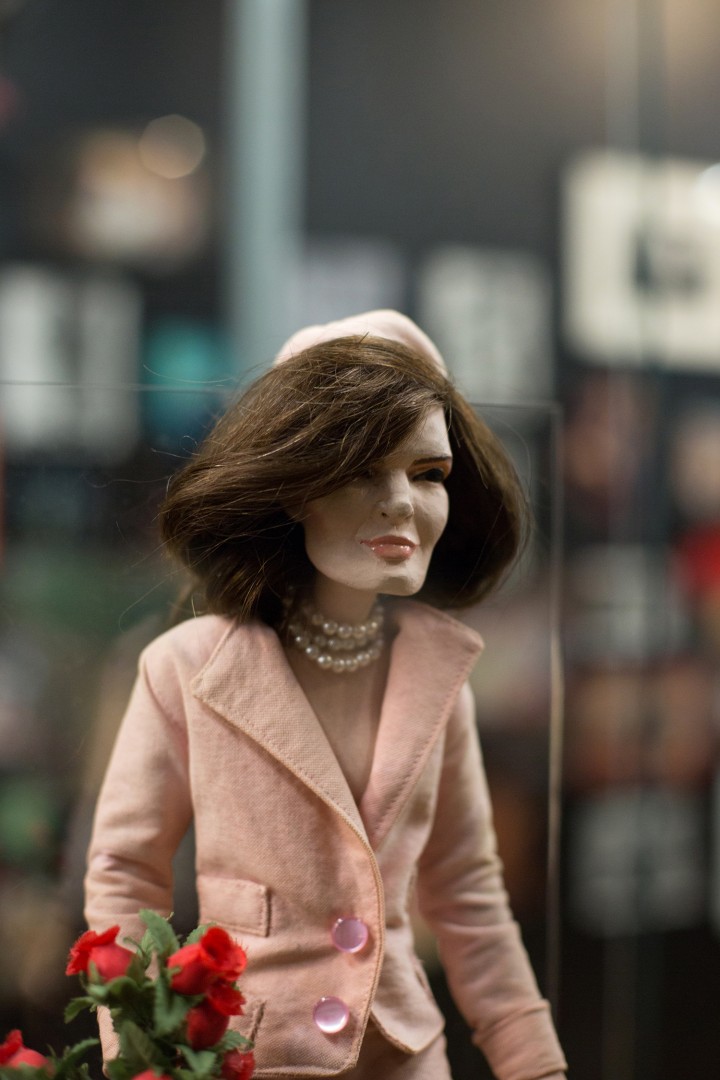
Although her work languished in relative obscurity form most of the 1990s and 2000s, Greer Lankton (1958–1996) was a seminal figure of the East Village art scene. She participated in several major retrospectives – including the 1981 “New York/New wave” show at PS1, the 1995 Whitney Biennial and the 1995 Venice Biennale – and had solo shows in 1983, ’84 and ’85 at Civilian Warfare, a gallery in Alphabet City. Eventually she moved to Chicago in the early 1900s, completing a final (and now permanent) installation at the Mattress Factory in 1996. It was her last show until her recent retrospective at Participant, Inc., in New York. A critical essay by Andrew Durbin, in memoir by her husband and Einsteins boutique founder Paul Monroe, and a series of photographs by Wolfgang Tillmans recount what might be called Lankton’s dual project of representing bodies (hers and others) while asserting their alienation.
Andrew Durbin on Greer Lankton’s queer experience of the world
In Peter Hujar’s 1983 portrait of her, the artist Greer Lankton sits in bed, her left arm propped up on her knee, holding her head up as she gives the camera a look of skeptical reserve. Her blankets and pillows are printed with large letters that spell out something interrupted by her body, likely a French phrase (one pillow reads “La” while the other appears to be “Nuit”). Every time I look at the photo I try to piece the letters into a sentence, but can’t. Likewise with her dolls, I can’t always put into words what it is I am seeing, despite how instantly recognizable some of her subjects are, from Jesus to Jackie Kennedy. Rather, the dolls seem to follow an unknown grammar of representation, one that insists on its own ineffability, on an otherness that attains familiarity yet remains distant and silent. The dolls, after all, do not speak. La… Nu…
Born Greg Lankton in Holly, Illinois, in 1958, Lankton transitioned to female in 1979 at age twenty-one, using funds her father collected at church. Lankton was “beautiful, glamorous, fragile, with a disarming sweetness and an ironic wit,” wrote Nan Goldin, her former New York roommate. She suffered, however, “through her own traumas: the pain from her surgery, her struggle with anorexia, her rejection by lovers, her drug problems” [“Nan Goldin on the East Village: A Chronology,” Artforum, October 1999]. After moving to New York in the late 1970s, she began to make large dolls, many of them resembling her diva-heroes like Divine and Candy Darling. Later she exhibited the work around New York at venues such as Civilian Warfare, a gallery in Alphabet City that included David Wojnarowicz in its roster of artists.

Lankton’s dolls are often anatomically unsettled, overweight or too thin, tattered or shredded open. They’ve been painted in a careful, expressionistic manner, one that sometimes verges on the comedic: Jesus, his mouth dripping with blood, is a zombie. They lean on their wire stands or against walls or on tiny furniture Lankton made for them. Their movable bodies appear threadbare, lopsided, sewn together with a provisional craftiness that reflects the fact that Lankton “constantly worked and reworked” them, as Goldin noted, “changing their genders, identities, sizes and clothes.” Julia Morton adds that “Greer’s dolls, ingeniously constructed out of soda bottles, coat hangers, umbrella hinges, panty hose, layers of paint and glass eyes obtained from a taxidermy shop, have a surreal yet jarring vitality […] Some dolls gained or lost weight, others had face-lifts or sex changes, and some were chopped into pieces and left as torsos or heads” [“Greer Lankton, A Memoir,” Artnet, January 1, 2007]. As such, they bear the look of the undead, mixing a peculiar humor with stopgap glamor, effecting a bodily presence in even the smallest of her works. Soulful yet haunted, they betray the same physical nuances that haunt our own flawed bodies. Hilton Als writes that they are “starved for attention” [“Doll Parts,” Document Journal, no. 4, December 2014]. Gary Indiana put it more generously in his 1984 review of Lankton’s third Civilian Warfare show: Lankton’s dolls “are so charmingly lifelike that their faces catch our attention first; or, in the gymnast pieces, the fluid grace they express in contortion.” He continues:
“We do, of course, notice these things almost immediately. Not to be funny, but they grow on us. Lankton’s creatures live in a psychic interzone where genitals and gender identity are scrambled in the play of appearances, and reveal an exacerbated, possibly mutilated sexuality as the trigger of personality. Like Theodora Skipitares’ housewife automata that vomit and menstruate, Lankton’s ambisexual dolls wear faces of crumbling self-assurance, or even moronic friendliness and self-contentment, while breathing pain out through their pores […] They have learned to live with an unalterable strangeness” [“Greer Lankton at Civilian Warfare,” Art in America, November 1984].

I’ll resist the obvious by stating that I don’t think Lankton’s work reflects a turbulent or tortured sense of her own body, despite her dolls’ sometimes turbulent and tortured nature. Rather, their re-visional quality suggests a distinctly queer and trans experience of the world, one that is attentive to physical mutability and the rotation and flexibility of “roles.” Diana Vreeland, Divine and Candy Darling, to name only a few of Lankton’s subjects, are linked thematically in their shared sensibility of the made-up, the invented, and so the changeable. They knew, like Lankton knew, that what was sewn into a boy can be easily cut into a girl, only to be later made into something else altogether.
Writing about the wax dolls of German artist Lotte Pritzel (to whom Lankton’s own work bears a strong family resemblance), Rainer Maria Rilke noted: “With the doll we had to assert ourselves, because if we surrendered to it there was nobody there. It made no response, so we got into the habit of doing things for it, splitting our own slowly expanding nature into opposing parts and to some extent using the doll to establish distance between ourselves and the amorphous world pouring into us” [“Dolls: On the Wax Dolls of Lotte Pritzel,” tr. Idris Parry]. This relationship imbues the doll with its “soul,” Rilke writes, arguing that it is the extremity of this attachment that leads us to both desire and reject the doll. Unalterable strangeness: Lankton’s own work is plotted along the rejection-desire axis, granting the work a peculiar levity that hovers between fearsome and friendly.
For Pritzel, working roughly a century before Lankton, this assertion of the self against — and into — dolls alchemized a sculpture of delicate figures infused with Orientalist twinkle, a toy world of near genderless bodies that, according to Rilke, “swarm and fade at the uttermost limit of our vision,” safe from any “decline in permanent sensuality.” This impermeability lends them a particularly dreamy quality, ghostly in the few extant images of them: their skeletal faces yearn “for a beautiful flame, to throw themselves into it like moths.” As such, Pritzel’s dolls — fragile artifacts of the brief twilight between the gay nineties and the founding of the Weimar Republic — are refugees of art, caught in the difficult obscurity between toy and sculpture.
This particular tension in Pritzel’s work is echoed throughout Lankton’s own, especially in her bust of Candy Darling, for which she made a glass chest with two fabricated hearts: a naturalistic one and a Valentine’s Day card cutout. In setting-up this core relationality, Lankton places the correspondence between the literal and symbolic at the figurative heart of her work (and of one of her heroes), laying bare, as it were, her duel impulse toward both. (Julia Morton writes that the two hearts indicate that Lankton was sustained by both “reality and fantasy,” though I’d reject the binary to say that Lankton was compelled by the hallucinatory interrelation of the two.)

Lankton’s art is both realistic and unrealistic, a difficult balance that is not unlike Candy Darling’s work as an actor, which often operated at the juncture between self-conscious play and unanticipated reality to evoke, again, unalterable strangeness. Following Douglas Crimp’s description of the superstar as someone who whose “self … recognizes otherness already there in itself [and] performs its own self-alienation” [Our Kind of Movie: The Films of Andy Warhol, Cambridge: MIT Press, 2012], Lankton likewise performs the double work of representing bodies (hers and others) while asserting their alienation. Darling rehearsed and played herself in order to be someone else. It might be said that Lankton rehearsed and played others in order to be herself.
Appearances crumble. Lankton’s best-known doll, Sissy (1979–96), which she worked on most of her career, has disappeared. Numerous photos of the doll still exist, giving an elliptical portrait (taken by Lankton) of the doll’s progression. In one, perched on a stoop, smoking next to a small dog, Sissy looks Joan Crawford-esque. In another, she’s broken into pieces, a dislocated and partially skeletal nude descending a staircase. In still another, Sissy is naked, wigless and with a red heart painted on its chest. Perhaps the most famous image of the doll is of it standing with a skullcap outside the Prince Street N and R train in SoHo. Sissy’s pants are pulled down to reveal male genitals. Graffiti on the station reads: Lady. It seems somewhat fitting, however terrible the loss, that Sissy disappeared: a translational and –itional object of identity, its continuous shifts — between identities and genders, between the fully formed and the partially skeletal — license an absence that follows Lankton’s own. We couldn’t know Sissy, except in parts, images, remnants, small traces of a figure that slipped, like its maker, above the uttermost limit of vision.

Paul Monroe on the ever-changing Sissy
1981: New York City is very gray. Not a pleasing gray but a harsh, aggressive gray. The first thing I did before opening my shop Einsteins in the desolate East Village was to paint the exterior neon green. It acted as a calling card, attracting a certain type of New Yorker: Kathy Acker, Peter Hujar, David Wojnarowicz, Iggy Pop and Diana Vreeland, to call out a few. Greer Lankton was a fan of the surrealistic jewelry I was designing, and she asked me if I wanted to collaborate. We had previously met at parties, in underground clubs and cafes, but didn’t really know each other. Lankton was very confident in her request, and I was flattered. Soon after, she created the first of hundreds of window installations at Einsteins. That’s how it all began.
Greer Lankton made weird “dolls” with visceral souls, spotlighting the unique, the unordinary. She created a copious amount of work in her short lifetime, starting at the age of two, when she made one of her first dolls out of flower stems while sitting alone in the backyard. At last count, she had made over three hundred pieces by the time of her death. She worked compulsively, her skill and knowledge the product of trial and error. She made dolls for the simple reason that she didn’t have anyone to talk with, and she reconstructed many of them, some literally to death: changing the sex, the age, the complete persona. Sometimes it was a matter of lacking money to purchase additional art supplies; sometimes it was due to lack of space (Lankton’s first studio/apartment was only 250 square feet).
At twelve years old, out of isolation and longing, she created the first of the life-size figures, a teenage boy with shoulder-length brown hair. The “doll” was constructed of old T-shirts that were cut up, sewn together and painted with acrylic paints. He had a penis, nipples and a deep navel. At sixteen, she transformed that first piece into a doll called DeeDeeLux, created in homage to legendary drag queen Divine. DeeDeeLux was unlike any other piece Lankton created: it was hollow, and Lankton figured out a way to zip inside it. A second skin, a new identity. Leaving the eye sockets empty and the mouth open, Lankton could easily navigate in this piece. On occasion she zipped herself inside the doll and spent an afternoon in the Chicago suburbs: dressed in a caftan, a headscarf and huge Jackie O sunglasses, stopping by yard sales. Lankton was doing then what people would refer to now as “guerrilla” performance art. In 1981, Lankton appeared in a film by Nick Zedd titled The Bogus Man, wearing the doll and dancing in a highly sexualized and humorous manner.

At the age of twenty-two, Lankton transformed this doll for the final time into a Rastafarian princess called Pamela. She closed up the back where she once could enter, filled the doll with foam and painted it entirely blue. She altered the body, nipping and tucking to reveal a classic hourglass silhouette. Lankton gave Princess Pamela beautiful breasts and a working vagina, and crowned her with a mass of dreadlocks made of steel wool, wire and human hair. Lankton showed this piece in her first solo show in 1982 at Civilian Warfare gallery, New York City. In 1988 Princess Pamela was purchased by Iggy Pop, who then employed the doll in a music video responding to the piece exactly as Lankton had desired — indeed, it was Lankton’s intent that when a person purchased her work they would interact with it and the doll would become a part of their family. She even provided additional clothes for certain pieces and was always happy to repaint or repair an over-loved doll.
Missy/Sissy was the third life-size figure. Weighing approximately 110 pounds and standing five feet eight inches, the doll was a close double to Lankton. This was Lankton’s ever-changing masterpiece. She first started working on this piece while recovering from the “operation,” her term for the sex change that took place in 1979, when she was twenty years old. I met Sissy in 1982: at the time, she was called Missy and had the demeanor of a drag queen of the highest order. Exaggerated glamour, fierce facial features that would be at home in any Federico Fellini film. Bald headed with large hand-blown green glass eyes that were the same shade as Lankton’s. She was one of the few dolls that had a full mouth of human teeth, taking Lankton’s work to a new height of realism. Missy/Sissy was fully jointed and anatomically correct. Lankton approached the human form in a very scientific fashion, constructing each doll as accurately as possible. A metal and wire skeleton was built up with layers of fabric and foam. Each layer of skin was hand sewn. The fingers would take weeks, and Lankton’s own would bleed in the process. The head, taking months to finish, was created in paper, plaster and wire.

Missy/Sissy’s ongoing metamorphosis obsessively occupied Lankton her entire life. One of the first major transformations of this piece was the “operation” in 1985. This time Lankton acted as the doctor. I was present, and it was an unforgettable experience. Lankton had just taken over the back rooms of Einsteins as a work studio. The studio had stark white brick walls and was completely empty, except for a Danish blonde-wood dining table. The original 1900s overhead ceiling fixture was circular and rather clinical — somewhat mimicking an operating lamp. Missy’s surgery was scheduled for 3 pm. Lankton covered the table with a heavy plastic tarp, and a small side table was set up with tape, scissors, pliers, sandpaper and a few blades. Lankton spoke lovingly to Missy/Sissy and explained what she planned to do. Fully theatrical, a performance for one. Lankton placed a plastic cup over the doll’s mouth to simulate ether sedation, stretched her “doll” out on the table and began hacking at the flaccid figure with a janky hacksaw. Lankton wore a denim surgeon’s smock she designed with black tights and flat red shoes. She wore her long blonde hair in a high ponytail, a cigarette dangling from the red bee-stung lips. As she dismembered the doll, she talked: a continuous stream of intense details; this was the centerpiece of her “operation.” Lankton had previously given me a compelling, sometimes harrowing account of the journey of becoming Greer: I already knew about how Lankton came out at age eleven, and about the endless times being caught in drag. I knew that Lankton’s mother ushered her to every doctor she could find, looking for a solution. I knew Lankton had to endure several stays at state-run mental hospitals, and went through prehistoric treatments like shock therapy, which beat her down to the point that she told me she “felt like a mute.” I knew that five psychiatrists had refused to authorize the sex change, telling Lankton’s mother there was no surgery to “cure” her child. I also knew that anything could get done given a cooperative private doctor. I had heard all that. But this time Lankton spoke of her father. We had been living together for over a year and I’d never heard anything disparaging about him.
Lankton looked at Missy/Sissy lying there and wondered out loud: “How could my father not stop her?” “He never said a word?” I asked. “Nothing.” Time froze when Lankton said, “Just lately, I’ve started thinking he didn’t protect me.”
Lankton removed the front of the gaunt torso with the penis attached, dismembering Missy/Sissy and pulling the fabric skin back to expose the wire skeleton. The “doll” would undergo feminization surgery, which was very popular in the trans community at the time. The walls were covered with reference pictures of glamorous stars: Sunny Harnett, Marlene Dietrich and Gena Rowlands. Lankton talked about how she wanted Sissy to look as if she were having hormone treatments. She achieved that by sanding down the jaw and the brow bones and softening the features. The “surgeries” would go on for the next few weeks until Sissy was ready for her debut in the shop’s window. In between procedures, Lankton would pose and photograph Sissy in an assortment of situations. Together we placed Sissy in the window. She reclined on a pile of silk pillows, naked and draped in jewels, and wearing a well-coifed blonde wig — moneyed. Lankton placed a handwritten note on a tray beside Sissy that simply said: “Introducing — Sissy — you’re welcome.”

For the next seven years Sissy was a “beacon” in the neighborhood. She had endless admirers. Performance artist Ethyl Eichelberger performed with Sissy onstage in a Shakespearian ode, while Ann Magnuson wrote a part for Sissy in a two-person short film. And Sissy was the “face” of Einsteins in numerous campaigns. Lankton exposed herself through Missy and then Sissy. On November 18, 1996, only weeks after completing her last solo show, “it’s all about me… not you” at the Mattress Factory in Pittsburgh, Lankton was found dead in her Chicago apartment. A month earlier, almost as an alert, Lankton had hung Sissy on a coat hook in the entry closet of the house she grew up in. She did not include Sissy in the last show, noteworthy since she practically emptied her apartment of all her work to send to the Mattress Factory. To exclude Sissy and move her to her childhood home, a place where Lankton had suffered so much — to me, this is an extremely emotional action. Sissy was repainted and her expression was removed. She hung naked, appearing unfinished. Yet, deliberately painted in the center of Sissy’s chest, there was a red heart with the phrase: “Love Me.”





